#adélie penguin
Explore tagged Tumblr posts
Text

George Marston (1882-1940). Polar Wildlife.Iink, watercolour and body colour on artist's board, captioned in ink.
Bonhams
#birds#penguins#adélie penguin#rockhopper penguin#emperor penguin#king penguin#seabirds#gulls#great black-backed gull#mammals#lagomorphs#hares#english hare#cape hare#pinnipeds#seals#ross seal#George Marston
588 notes
·
View notes
Text

Adélie penguin chick By: Unknown photographer From: Wildlife Fact-File 1990s
143 notes
·
View notes
Text
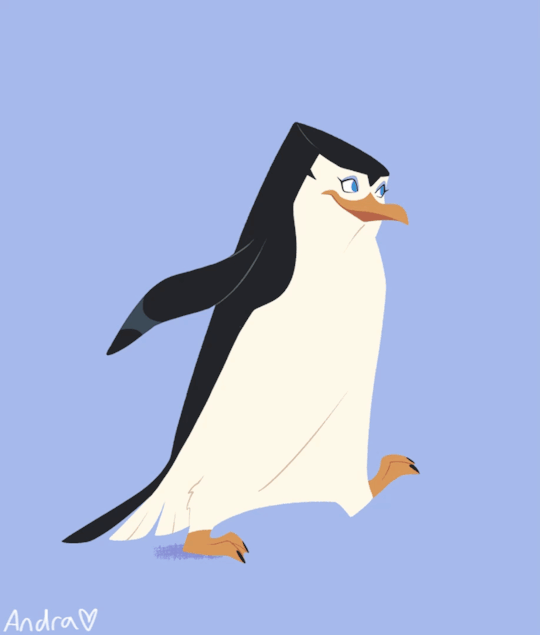
Waddle waddle 🐾
I’m obsessed with how Adelie penguins walk they’re so cute lol
#tpom#tpom skipper#the penguins of madagascar#penguins of madagascar#madagascar movie#pom skipper#skipper penguin#pom#animation#animation gif#walk cycle#adélie penguin#he’s just a little guy#a cutie patootie
172 notes
·
View notes
Text

An Emperor penguin and three Adélie penguins, near Mawson Base, Antarctica, 1965. Photo by Don Allison
103 notes
·
View notes
Text
what i think different penguin species would think about flying:
Emperor penguins

Emperor penguins dream about being able to fly as chicks and each one is very convinced *they* will be the one to first accomplish it. As they grow up, however, they lose interest in flying and become content with the way they are.
Adélie penguins

The concept of flying is actually a laughing matter to the Adélie penguins. Why would you want to fly? Ever seen a fish in the sky? I don't think so. You know what is in the sky? Skuas. And nobody likes those guys.
Chinstrap penguins

Chinstrap penguins get heavily annoyed when the topic of flying is brought up so it's best not to. Maybe chinstraps are bitter because they can't fly. Or, maybe, it's simply because flying birds (like skuas and petrels) are always bad news for the chinstraps.
King penguins

Flying is nice, but King penguins are okay with not being able to fly. Really, theyre over it. Believe them.
Gentoo penguins

Gentoo penguins are strong believers in the idea that penguins can, indeed, fly, they only do it underwater. Don't try to correct them on that, it's very rude.
Rockhopper penguins

Flying is a highly divisive topic amongst all subspecies of rockhopper penguins. Better not bring it up at all to avoid squabbles.
African penguins

African penguins wouldn't mind being able to fly as long as they don't have to trade off their swimming and diving skills. It would be convenient.
Fiordland penguins

Fiordland penguins would much prefer the ability to climb trees very well. But flying is the next best thing.
Yellow-eyed penguins

Yellow-eyed penguins show no particular interest in flying. They do, however, envy the penguins from Antarctica with no land predators.
Little blue penguins

Little blue penguins would love to be able to fly, it would be so much fun to them.
#i wanted to add more but im too lazy to go on computer so im working with 10 pictures limit#penguin#penguins#birds#emperor penguin#adélie penguin#chinstrap penguin#king penguin#gentoo penguin#rockhopper penguin#african penguin#fiordland penguin#yellow eyed penguin#little penguin
96 notes
·
View notes
Text
Wet Beast Wednesday: Adélie penguin
I previously covered the world's most famous penguin, the emperor. Today I'll be covering its less famous neighbor, the Adélie penguin. While being much smaller than the emperors, Adélie penguins are just as charismatic and highly ecologically important. They were named after the wife of the explorer who first described the species. Let's see if that was romantic or a mistake.

(Image: an Adélie penguin standing on a rock and facing the camera. It is a bird standing upright with flipper-like wings and webbed feet. The belly is white while the head and back are black. There are white rings around the eyes. End ID)
The Adélie penguin (Pygoscelis adeliae) looks like a penguin. Like picture a generic penguin in your mind and it'll probably look like an Adélie. They are flightless birds that stand upright, a posture that seems to be unique to penguins. They have countershading, with a black back and white underbelly. The most distinctive feature of an Adélie penguin is the white ring around its eyes. As with other penguins, Adélie penguin wings have adapted into flippers that enable powerful and graceful swimming but renders them flightless. Adélies reach a height of 73 cm (29 in) and a weight between 3.8 and 8.2 kg (8.4 to 18.1 lbs). The primary difference between males and females is that males are significantly heavier than females of the same size. As with most penguin species, it can be difficult to tell males and females apart without examining them. Adélie penguin feces and nasal discharge has been noted to be high in salt, the result of living in a very saline environment. By ingesting salt and nitrogenous substances in the sea and excreting them on land, the penguins help hasten the movement of nutrients from sea to land. This makes the penguins highly important to the antarctic ecosystem.
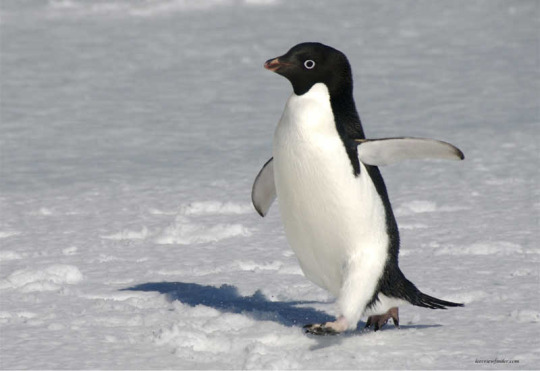
(Image: an Adélie penguin seen from the side as it walks over snow in a very dapper pose. End ID)
Adélie penguins are are one of the two penguin species to inhabit Antarctica itself, the other being the emperor penguin. They also share the many antarctic islands with multiple other penguin species and are rarely found as far north and Australia, Aotearoa/New Zealand, and South America. The penguins spend most of their time out on the pack ice, hunting for food to build up the layer of protective subcutaneous fat that helps keep them warm. Adélie penguins can be found hundreds if not thousands of kilometers from shore as long as there is access to the sea and ice flows to rest on. As the ice extends hundreds to thousands of kilometers in winter and retracts during the summer, the penguins will be on the move to retain access to the water. A penguin can migrate up to 13,000 km (8,100 mi) every year to retain access to both ocean and sea ice. They hunt and forage underwater, with a diet consisting primarily of krill, fish, squid, and jellyfish. Chemical analysis of shell fossils has revealed a change in diet from primarily fish based to primarily krill based around 200 years ago. It is believed that this change in diet was due to whaling diminishing the local baleen whale population, which was the primary krill predator. This resulted in a population boom of krill that the penguins took advantage of. It is very cool to me that you can tell what diet animals from thousands of years ago analyzing ancient eggshell remnants. Adélie penguins swim at around 8 km/h (5 mph) and can leap 30 meters out of the water to reach ice flows.

(Image: a group of Adélie penguins leaping off of ice and into the water. End ID)
Adélie penguins are noted to be very curious and fearless on land. They have no land predators and therefore have no predation response on land. Antarctic explorers have recorded that Adélie penguins would walk right up to charging and barking dogs without fear and quickly get eaten. They have been called boisterous by explorers and have been seen challenging much larger creatures to fights over space. During the filming of the BBC Earth documentary Spy in the Snow, the filmmakers caught footage of an Adélie penguin deliberatly protecting a group of emperor penguin chicks from a southern giant petrel who was hunting them. Despite the petrel's threat and the chicks being of a different species, the Adélie put itself between the predator and prey and repeatedly charged the petrel (which occasionally hunt adult Adélies) until it gave up and left. Adélies are not always as nice to each other. They will fight each other, especially during breeding season. Adélies are known to be reluctant to enter the water if they can't see another penguin swimming safely. They will gather in groups on the edge of the ice until one penguin gets pushed in. If that penguin doesn't get attacked by a predator, the rest will join.
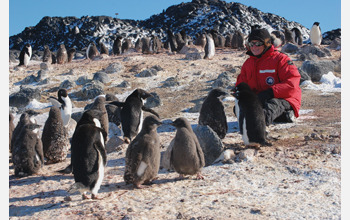
(Image: a group of Adélie penguins being examined by a scientists sitting on the ground in a red coat and black pants. The group includes adults and chicks. The penguins show no fear of the scientist and some appear to be examining them. End ID)
Mating season lasts between October and February. During mating season, the penguins gather in rocky areas with no ice covering. The males gather piles of pebbles which will become nests. Males will try to steal pebbles from each other, which can led to fights. Once his pile is complete, the male will stand on top of it and begin a display involving pointing his beak up, vibrating his chest, and flapping his wings. A female who is wooed by his display will approach and bow, which he will then reciprocate. The male then shapes the nest into a pit and lets the female lay down in it. The male stands on the female's back to mate and they will rub beaks together while doing so. Adélie penguins are serially monogamous. They will form mated pairs during mating season, but will usually not pair off with the same penguin next season. On the other hand, Adélie penguins have been suggested to engage in prostitution. Males have been known to mate with females they are not paired off with, after which the female will take some of the stones from his nest. The reasons for this behavior is not clear and calling it prostitution may be applying human ideas to non-analogous animal behavior. Females may be examining males as potential backup mates should hers die. The male allowing the female to take some stones may also be an advantageous trait as if she does lay his eggs, having better stones will give them a better chance of surviving with him not there. Adélie penguins are notorious for their aggressive sexual behavior. Males will attempt to forcibly mate with females (possibly as a result of mistaking her bending over as a mating bow) and males without partners will attempt to mate with such things as chicks, dead penguins, and the ground. During mating season, males accumulate the hormone corticosterone in their systems. This hormone increases aggressiveness and sexual activity in birds and is likely why males who can't attract a mate will attempt to mate with anything they can.

(Image: two Adélie penguins mating. The male is standing on top of the (presumably) female, who is lying stomach-down on the ground. The male's head is bend down and the female's head is bent up so their beaks touch. End ID)
After mating, the female will lay two eggs, the second a few days after the first. If one egg is lost soon after being laid, a third may me produced to replace it. The second egg is usually smaller then the first so they will still hatch around the same time. The father and mother share share incubation duties. One parent will sit on the eggs to warm them while the other parent returns to the sea to feed. The incubating parent will not leave the nest during this time. They do not eat while incubating and will projectile defecate to keep feces away from the nest. Shifts change every 7-10 days, allowing both parents to eat while keeping the eggs incubated. When both parents are at the nest, they will perform a mutual display involving waving their heads while calling out and bowing to each other. The eggs hatch after 32 to 34 days and the chicks will remain with their parents for another 22 or so days. During this time, the parents will take shifts guarding the chick and returning to the ocean to feed. The chicks are fed regurgitated, partially-digested food. Mothers who have lost their chicks have been known to try to steal chicks from other parents. After the 22 days, the parents abandon their chicks and return to sea. The chicks gather together in groups called crèches for mutual protection from predators. They must subsist on fat stores for another 30 to 40 days before developing their adult plumage and setting out to sea.
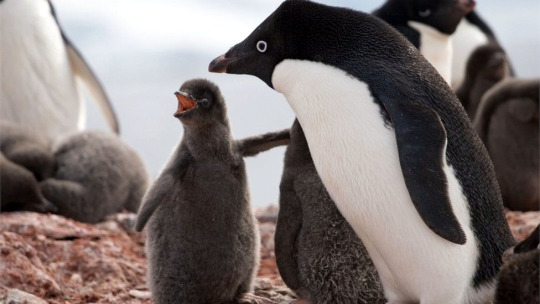
(Image: a group of Adélie penguins with a focus on a parent and a chick. The chicks are smaller than the parent and are covered in gray, fluffy down. End ID)
One of the earliest texts on Adélie penguin behavior came from the journal of the explorer George Murray Levick in 1911-12. He described the sexual behavior of the penguins but the result was considered too explicit and immoral to be publiched with the rest of the expedition's notes. As a result, Levick's noted were not discovered and published until 2012. One of the things in the notes that resulted in them being denied publication was the description of homosexual behavior. That's right, this is a surprise pride post. Despite what many conservatives would like you to believe, homosexual behavior is very common in the animal kingdom. Penguins are seemingly especially known for this behavior. While initial reports suggested that Adélies would accidentally mate with other males as a result of mistaken identity, this have been proven to not be the case every time. Male Adélies have been seen taking turns copulating with each other, which means they definitely realize the other is male. Similar behavior has been seen in other penguins. Famously, a male/male pair of chinstrap penguins (a close relative of the Adélies) named Roy and Silo in New York City's Central Park Zoo successfully fostered an egg and hatched a female chick named Tango, who also went on to bond with another female penguin. Multiple other species have also been know to form same-sex bonds in captivity (wild behavior being harder to study) with many even building nests and using round stones in place of eggs. Same-sex pairs have been known to bond with each other year after year when other penguins will chose different mates each year. Multiple zoos will let same-sex penguin pairs to foster eggs.
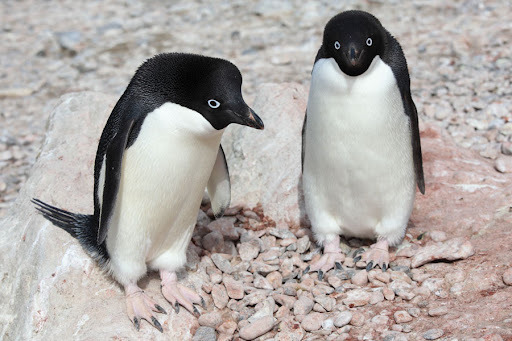
(Image: two penguins standing among a pile of pebbles. End ID)
Levick's notes on homosexual behavior in the Adélie penguins described them as deviant and disgusting. I bring this up because it leads me to a point I want to discuss. It is very important to not judge animals by human moral standards. Study of homosexual behavior in animals has been distorted and repressed by generations of scientists operating under an Abrahamic religious worldview where homosexuality is considered a crime against nature. In that worldview, it would not be possible for animals to be homosexual because now could nature commit a crime against nature? Thus, the use of rationalizations, deceptions, and cover-ups by scientists operating under that worldview. When the facts conflicted with their beliefs, they chose their beliefs. This is not the only time this has happened. Back in the early days of paleontology, famous paleontologists such as Sir Richard Owen discovered that theropod dinosaurs had similar traits to birds and that dinosaurs were not the slow, lumbering, lizard-like animals they were initially assumed to be, but highly developed, powerful animals. This conflicted with their pre-conceived religious beliefs in Biblical creationism where all species were created as they were and did not evolve and that modern species must be the better versions of past species as God wouldn't replace something powerful like a triceratops with something less powerful like a cow. These early paleontologists covered up and denied evidence that went against their beliefs and in doing so, set back the fields of paleontology and evolution in ways we are still trying to fully recover from. Failure to separate our moral standards from animal behavior is important to studying animals for the same reasons that those early paleontologists failing to separate the evidence from their religious beliefs was. I have heard popular animal Youtubers insult animals like Adélie penguins and dolphins in exactly the same way Levic did because of their behavior when mating. Those kinds of attitudes are thing we need to get over when studying nature. Nature is under no obligation to conform to the many and varied moral standards of humans and we need to recognize that. This doesn't just apply to people who disapprove of animal behavior. You will notice that I never called any of the penguins "gay" or anything similar in the above passage. That was deliberate and it's not because "I'm a homophobe trying to to deny that gayness exists in nature" or anything like that. That would be a pretty fucking hypocritical thing for me, a trans lesbian, to believe. I don't think it's fair or intellectually honest ascribe human descriptions of behavior and psychology to nonhuman animals. We have very different psychological makeups from penguins and the definitions we use simply may not apply to them. Similarly, penguin mental constructs or concepts wouldn't apply to us, at least not in the same way. Nobody can read a penguin's mind and nobody can Animorph into a penguin to experience its psychology first hand. If Roy and Silo were able to talk, would they identify themselves as gay? Would the modern, western idea of gay even make sense to a penguin? I have no idea and neither does anyone else. And I think applying labels for human concepts like being gay that may or may not apply to an animal risks introducing bias to our understanding that can produce mistakes and misunderstanding about that animal's behavior. This is true whether you think being gay is good (like me and hopefully everyone reading this) or bad (like Levick did).
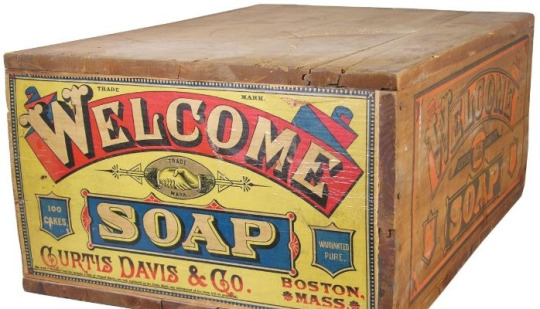
Oops, what's this doing here? (Image: an old-fashioned soapbox. End ID)
Adélie penguins are classified as Least Concern by the IUCN. This does not mean they are not facing challenges. The loss of sea ice due to global warming has reduced the available habitat and has seen population drops. Chick survival rates have also been decreasing. In addition, as of 2024, a mass die-off of over 500 birds was discovered and is being attributed to H5N1 bird flue spread from South America. This strain has also been found in local skuas, which could act as vectors to spread to to other species and populations. This situation is currently under investigations and we currently can't predict where it will lead.
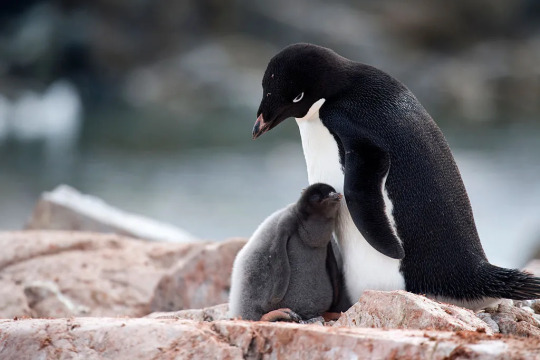
(Image: an Adélie chick nuzzling its parent's belly. End ID)
#wet beast wednesday#adelie penguin#adélie penguin#penguin#bird#antarctica#homosexual behavior in animals#pride month#pride#marine biology#biology#zoology#ecology#animal facts#ornithology#informative#educational#image described
77 notes
·
View notes
Note
Trick or treat! o(^v^)o 🧡🖤🎃

Here is an Adélie penguin for you!
17 notes
·
View notes
Text

"A modern dancer," by Nadia Haq
Adélie Penguin, (Pygoscelis adeliae). Antarctica,
Comedy Bird Photo. Gold award winner 2024.
#art#surreal#photography#fun#funnyshit#funny#funny pictures#funny shit#funny picsdancer#sliding#nadia haq#adélie penguin#penguin#antartica#comedy#bird#funny pics
14 notes
·
View notes
Text

An Adélie penguin glides across the sea ice near Brown Bluff, Antarctica. Nadia Haq / Bird Photographer of the Year 2024
6 notes
·
View notes
Text
hey tumblr. this is extremely important... there's a penguin. he has been named steve. he apparently doesn't like to use his flippers, unlike the other adelies. It is quite possibly the cutest and silliest thing EVER.
I LOVE STEVE, LONG LIVE STEVE!
instagram
instagram
instagram
instagram
7 notes
·
View notes
Text
Happy world penguin day!!

I am going to go over some interesting penguins, they could be interesting because of their names or adaptions.
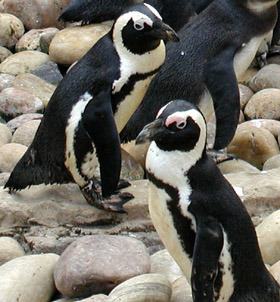
These guys are the African Penguins. The African Penguin is the only one of 17 penguin species that lives in Africa. This penguin is also known as the Jackass penguin because they have a noisy squawks. These squawks sound like the braying of a donkey therefore getting the nickname the Jackass penguin. In the language Afrikaans they call the African penguins brilpikkewynn (pronounced bril as in brilliant-puh-kuh-vain), this translates to English as braying penguin.
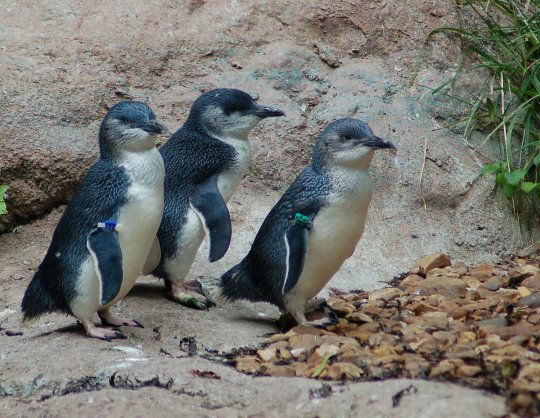
New Zealanders call these penguins Little Blue Penguins or just Blue Penguins. Australians call them Fairy Penguins.thw names come from the small size the fairy penguins have. Fairy penguins are actually the smallest species of penguin. The fairy penguins have indigo-blue or slate-blue feathers on their backs as you can see in the image above. The scientific genus name (Eudyptula) means good little diver. Fairy penguins do not migrate. They live year-round on their mainland or island locations in the southern hemisphere

Some species of penguins propose to each other with a pebble. Adélie penguins are actually one of those penguins. When the two penguins are dating, the male penguin will give the female a pebble. If the pebble is accepted by the female the two penguins will mate for life. When Adélie penguins mate for life and return to each other at the same nest every year. The nest will be a pile of pebbles.

The population status of eastern rockhopper penguins is unknown. The eastern rock hopper penguins are located on several islands in the Indian and Pacific oceans. The penguins specifically live in sub-artic locations, such as the Crozet and Kerguelen islands. Eastern rockhopper penguins spend most of their lives at sea and only return to land to molt and breed.

At least 85% of northern rockhoppers are located on the islands of the Atlantic ocean Gough and Tristan da Cunha. of the Tristan da Cunha archipelago and Gough Island in the Atlantic Ocean. The population of the Northern rockhoppers has decreased about 90% since the 1950s.
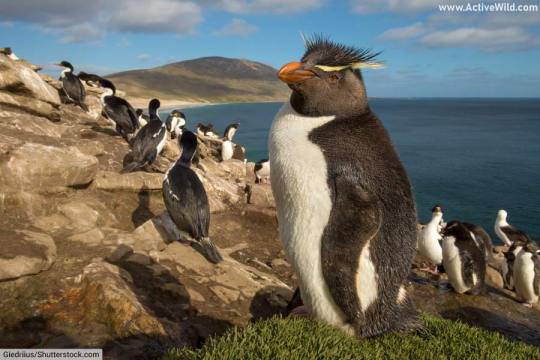
The Southern rockhopper penguins are classified as vulnerable and have decreasing population size. This species of rockhopper penguins live on the coastlines of Chile and Argentina, as well as the Campbell island in New Zealand. The Southern rockhoppers are found on several other islands in the Pacific, south Atlantic and Indian oceans. The Southern rockhoppers have a narrower stripe of yellow over their eyes than the Northern rockhoppers.

The Magellanic penguin is the most common type of banded penguin. They are a medium to large penguin that have a thick black line running across their white chest. Magellanic penguins have white border surrounding their face. During breeding season Magellanic penguins are found on the Falkland Islands as well as the coast of southern south America. In the winter they migrate as far north as northern Brazil.
There are also some gay penguins. People have served penguins engaging in homosexual behavior since as early as 1911. The first documented case of homosexual penguins was not released to the public until a century later due to the report being "considered too shocking for public release".
#magellanic penguin#jackass penguin#african penguin#fairy penguin#little blue penguin#adélie penguin#rockhopper penguin#northern rockhopper penguin#Southern rockhopper penguin#eastern rockhopper penguin#world penguin day#cute penguins#gay penguins#homosexual penguins
30 notes
·
View notes
Text

Adélie penguin chick By: Frans Lanting From: Natural History Magazine 1989
109 notes
·
View notes
Text
Low Ice Levels in Antarctica Killed Thousands of Penguin Chicks, Study Says
Thousands of penguin chicks in four emperor penguin colonies likely died after Antarctic ice broke up earlier than usual last year, creating a “catastrophic breeding failure.” In a study published this week in Communications Earth & Environment, researchers from the British Antarctic Survey outlined the very high probability that most chicks from four out of the five known emperor penguin…
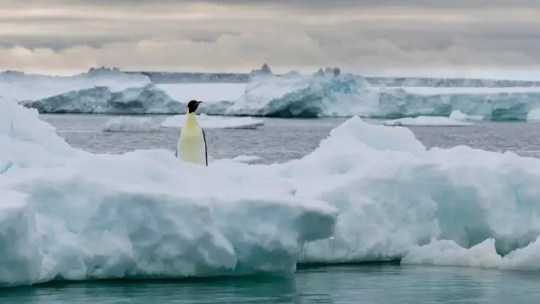
View On WordPress
#Adélie penguin#Antarctica#Bird#Emperor penguin#Environment#Flightless birds#Gizmodo#Human Interest#King penguin#Penguin#Peter Fretwell#Tern#the u.s. fish and wildlife service
2 notes
·
View notes
Text
adélie penguins look like they have googly eyes gsgsgg
2 notes
·
View notes
Text

A gentoo penguin leaps from the water onto a rocky shoreline near Port Lockroy on Wiencke Island (Antarctica).
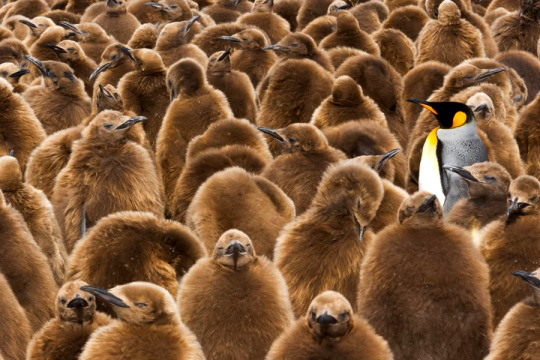
One adult king penguin in a large crowd of king penguin chicks, in a breeding-colony group on South Georgia island.

King penguins gather along St Andrews Bay on the island of South Georgia.

Chinstrap penguins swim through the surf toward Bailey Head on Deception Island.

Close-up view of a rock-hopper penguin.

A group of crested penguins dart past one another underwater.

A colony of emperor penguins with their chicks on Snow Hill Island (Antarctica).

An emperor penguin cares for its chick on Snow Hill Island.

An Adélie penguin looks out from behind a pile of snow in the Yalour Islands.

A gentoo penguin pokes its head under the water's surface near Horseshoe Island.

An elephant seal, surrounded by king penguins, on Île de la Possession.

A penguin swims along Arpoador beach in Rio de Janeiro (July 2012), during the annual migration from Argentila, Chile, and the Falkland Islands.

Penguins gather on the Punta Tombo peninsula in Patagonia (Argentina, 2017).
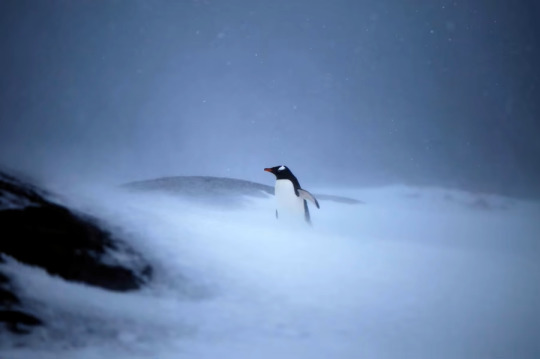
A gentoo penguin walks through an Antarctic storm.

Penguin footprints on Danco Island (Antarctica).
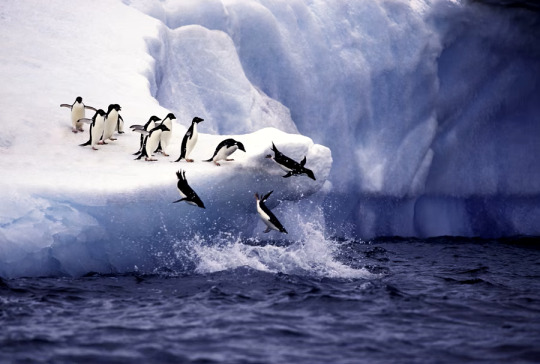
Adélie penguins jump off an iceberg into the water off Paulet Island (Antarctica).

A leopard seal hunts for gentoo penguins on Cuverville Island.
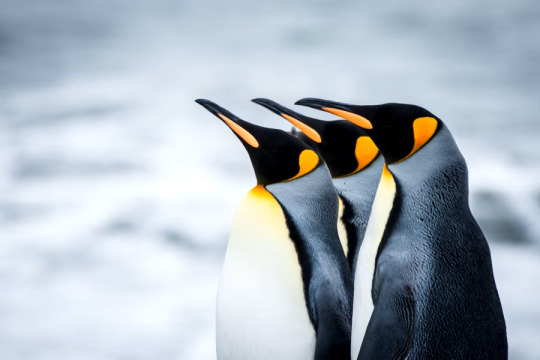
Three king penguins.

A massive colony of king penguins on South Georgia island.
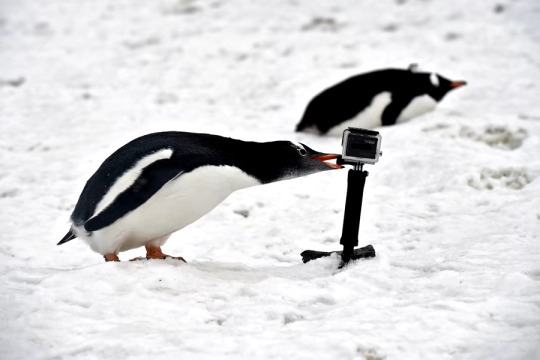
A gentoo penguin nips at a camera along Orne Harbor, on the western side of the Antarctic Peninsula (March 2016).
#photography#birds#penguins#seals#antarctica#brazil#argentina#gentoo penguin#king penguin#chinstrap penguin#rockhopper penguin#crested penguin#emperor penguin#adélie penguin#elephant seal#leopard seal#it was world penguin day the other day so HAVE SOME PENGUINS!!!!#i cannot figure out how to add a title to a draft so that is very annoying#oh well it is obvious that they are penguins#my favourite is the last one hehehehe
6 notes
·
View notes